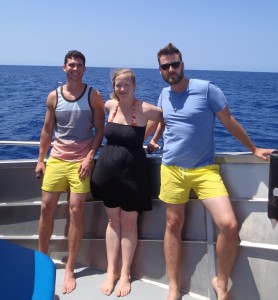A steel cage was the only thing separating us from 15 circling Galapagos sharks. Before we entered the cage, the crew from North Shore Shark Adventures played the theme from “Jaws” over the loud speaker on the boat, pretended not to hear it and then said that sometimes people imagine the “Jaws” theme in their heads right before entering the water.
North Shore Shark Adventures operates boat tours out of Haleiwa Harbor. The 2-hour tours motor out close to three miles offshore, and then tie up to a metal cage floating on the surface. The cost is $96. The square cage is about eight feet in length and width and about eight feet deep. Roughly six people enter the cage at a time and then are allowed 20 uninterrupted minutes to observe the sharks.
“My favorite thing to do was swim down to the bottom of the cage, wrap my arms around the bars, and stick my head between them,” Dan Schade, 26, of San Francisco said. “It was like there was no cage at all and the sharks just swim so close to you.”
The crew at North Shore Shark Adventures doesn’t need to use the traditional method of chumming to get the sharks to come up to the boat. Chumming, a controversial and sometimes illegal practice, is using blood and animal parts as bait in order to attract sharks. The crew explained that over a period of more than 40 years, the sharks have been conditioned to the sound of the boat’s diesel engine. They said that their tour boat uses the same engine that the crab fishermen have been using for the past 40 years. The crab fishermen would throw the excess crab and fish that were caught in their nets into the water and over the years the sharks began to associate the crabbing vessels with food.
The crew also used another effective method to bring the sharks to the surface. They have a shiny silver water bottle attached to a piece of rope. The crew throws the water bottle into the water, and the sound of the bottle splashing as well as the shiny reflection cause the sharks to come investigate.
Schade, along with his good friend and business partner David Parfitt, also tried another method to lure the sharks in, although very implausible, of wearing matching bright yellow bathing suits.
“We had no idea we were going to be wearing the same thing today,” David Parfitt, 29, of San Francisco said with a smirk.

It was hard to imagine these sharks as bloodthirsty creatures that snack on human beings when in the water with them. They are so graceful and they appear to swim in slow motion. To observe nature up close is to begin to question the stereotypes that the media portrays. Only the shark attacks, particularly the fatal ones, are covered by the media.
According to the International Shark Attack File at the Florida Museum of Natural History, “In general, the number of worldwide unprovoked shark attacks has grown at a steady pace since 1900, with each decade having more attacks than the previous. The numerical growth in shark interactions does not necessarily mean that there is an increase in the rate of shark attacks; rather, it most likely reflects the ever-increasing amount of time spent in the sea by humans, which increases the opportunities for interaction between the two affected parties.”
Seeing these sharks up-close in their natural environment has the opportunity to give you a new and different perspective on these creatures that are usually vilified in the media.